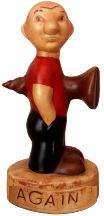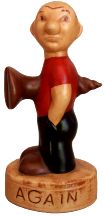 |
 The Virtual Corkscrew Museum's Weekly Newspaper |
 |
 |
 The Virtual Corkscrew Museum's Weekly Newspaper |
 |
|
Sunday May 27, 2007 |
Ice Reducing Tools
Many corkscrews have been combined with an ice pick, ice cracker, or ice chopper. Even Avillar's 1929 U. S. Design Patent Parrot was offered as an ice cracker.
In his new book Patented Ice Reducing Tools: An Identification Guide for Hand-Held Picks, Chippers, Crushers, and Shaves, Bob Roger shows that there were indeed a very large number of corkscrews with "ice reducers". This large well illustrated 330 page tome presents an amazing story of the history of ice reducers through patents and photos. A great book for the tool collector as well as the corkscrew enthusiast.
In his introduction, Bob writes "What appears to be missing from the literature is information about the hand-held ice reducing tools used by the iceman, merchant, housewife, and others to break down (reduce) large blocks of ice.
Doctors used ice for medical treatment, grocers used ice for preservation of vegetables and meats, and domestics used ice for making ice cream and cooling drinks and shaved ice for snow cones. Examples of other uses are breweries who needed ice to chill beer during fermentation, and meat packers who needed it to refrigerate fresh meat in boxcars.
Ice in a reduced form was used in wide variety of applications, and still is. But other than a few items mentioned in some reference books or catalogs, no one seems to have written specifically about the many hand tools that were invented and used to reduce ice. This book will attempt to fill that void."
Bob does very well at filling that void and for corkscrew collectors he offers a wealth of knowledge. Just to mention a few combination corkscrew tools with ice reducers that the enthusiast may find of interest: Dickson's 1871 patent, Shelley's 1879 patent, the Wenham Ice Hammer, Wyler's 1948 key patent, Jensen's Kactus pattern set, Watrous Royal Danish pattern, the Men in Fez and similar bar sets, the Bar Bum, Chip Chop, Wood's 1890 patent, Old Snifter, and many more.
Ice Tools offered by the Williamson Company of Newark, New Jersey.
Editor's Note: Bob Roger is a collector of corkscrews and a wide variety of tools. He is the author of A Guide to Gimlets published in 2003. His new book on Ice Reducers book is available directly from Bob Roger at $44 including postage and shipping to continental U. S. locations. Email Bob at toolman@rica.net
Hunting for Ice Reducers
Can you find the ice reducers in these photos?:
Bar Bum (with Ice Reducer)
On September 12, 1950 Samuel L. Gerson was issued United States Design Patent Number 160,082 for his "Bar Utensil."
The Delsam Company of Vineland, New Jersey called Gerson's design "The Lovable Bar Bum, A handy man for your bar." His hat is a bottle opener, his ear is an ice or nut cracker and his pants are a jigger. Removing the bayonet fit top reveals an ice pick, muddler and corkscrew. He was produced in painted, bronzed and aluminum finishes.
Whatsit
This tool appeared in the 2006 auction of the Alf Erickson corkscrew collection. It was listed as a "Whatsit". Some thought it might be some sort of crude cork remover where the sharp teeth are forced through the cork and then the prongs are engaged with the bottom of the cork for lifting. It sounded like a remote possibility yet requiring such force to get the teeth through the cork that it might first push the cork into the bottle.
The mystery is solved in Bob Roger's Patented Ice-Reducing Tools. It is U. S. Patent Number 348,858 of September 7, 1886 issued to Otto T. Moock and George H. Regar. Roger writes "The tool has blades on its end and is rotated into the top of the block (of ice) for a short distance, cutting a round hole in the block about 3/8 of an inch in diameter. When the handle is then pulled, the internal hooks are pushed outward to engage the ice at the sides of the block. The weight of the block keeps the hooks engaged as the ice is lifted and carried."
Email Bob at toolman@rica.net.
Old Snifter Breaks the Ice
|
©2007 Don Bull, Editor |